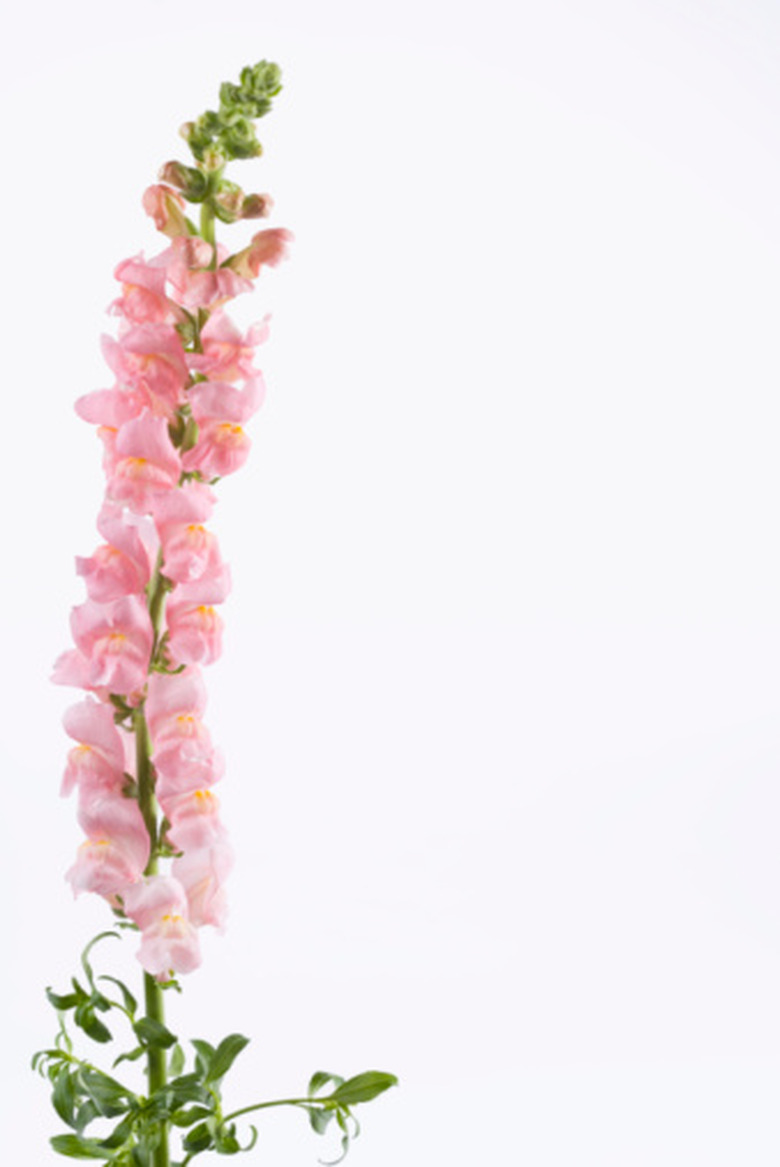Flowers That Look Like Snapdragons
Large and varied, the figwort family ("Scrophulariaceae") has many members with blossoms similar to those of common garden snapdragons ("Antirrhinum majus"). These include wildflowers that are sometimes cultivated in home gardens and which may be considered beneficial or invasive, depending on where they're grown. Some have flowers that look like those of open-faced antirrhinums, while others have the standard jawlike snapdragon blossom that opens like a dragon's mouth when squeezed. Few, however, come in the broad range of colors featured by their garden-variety cousins.
Summer Snapdragon
The trumpet blossoms of summer snapdragon ("Angelonia augustifolia") look similar to open-faced, "butterfly" snapdragons and come in shades of pink, rose, lavender, purple and white. The wide-open mouths of some cultivars, such as AngelMist Dark Rose, look like members of a choir bursting into song on their arching 18- to 36-inch stems. Native to Mexico and the Caribbean, angelonia flowers love heat and thrive as summer annuals in USDA hardiness zones 9 to 11. They blossom all summer long in southern states, unlike garden snapdragons, which prefer cooler weather and only blossom fall through spring in states such as Mississippi.
Island Snapdragon
Hummingbirds love darting from one crimson blossom to another in the lime-colored foliage of the island snapdragon bush ("Galvezia speciosa"). Similar to other members of the figwort family, island snapdragon prefers full sun. This native of Southern California's Channel Islands grows well on slopes and in hanging baskets. Its flowers, which blossom year-round, have the jawlike configuration of garden snapdragons. A close relative, the Baja snapdragon ("Galvezia juncea"), has slender, cherry-red blossoms that grow on the tips of long, rushlike branches reaching up to 5 feet tall. Both shrubs are perennials that are cold-tolerant to USDA zone 9.
Toadflax
Toadflax plants have butter-yellow blossoms with the same jawlike shape as garden snapdragons. While yellow toadflax ("Linaria vulgaris") has long, blade-shaped leaves that are somewhat akin to the foliage of garden snapdragons, dalmation toadflax ("L. dalmatica") has heart-shaped leaves. Both plants, however, are listed by the USDA as invasive non-native plants that are illegal to plant or sell in some areas. Originally imported as ornamentals, toadflax plants now are unwanted weeds that harm the environment by crowding out beneficial plants needed for animal forage.
Seep Monkeyflower
There are many species in the monkeyflower clan ("Mimulus"), which has long been placed in the figwort family but which plant taxonomists now think may belong to the lopseed family ("Phrymaceae"). Though the deep-yellow flowers of seep monkeyflower ("M. guttatus") resemble those of snapdragons, it gained the "seep" part of its name from thriving in the constantly wet rocky seeps of cliffs and along creeks and rivers, which indicates a love of damp roots–something that doesn't appeal to garden snapdragons. Although well-loved and native to the Pacific Northwest, seep monkeyflower is gradually becoming an invasive species elsewhere, especially along European waterways.
References
- Ciemson University Extension; Test Your Knowledge – May; Joey Williamson; 2010
- Tree of Life Nursery: Bush-Snapdragon – Galvezia
- North Dakota State University Extension; Dalmation Toadflax, Yellow Toadflax: Identification and Control; Rodney G. Lym; 2002
- North European and Baltic Network on Invasive Alien Species; Mimulus guttatus; Barbara Tokarska-Guzik and Zygmunt Dajdok; 2010
- Weeding Wild Suburbia; Irresistable Monkeyflowers; September 2009
